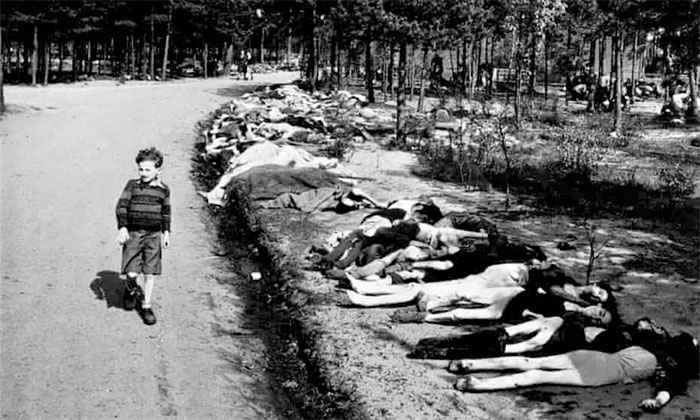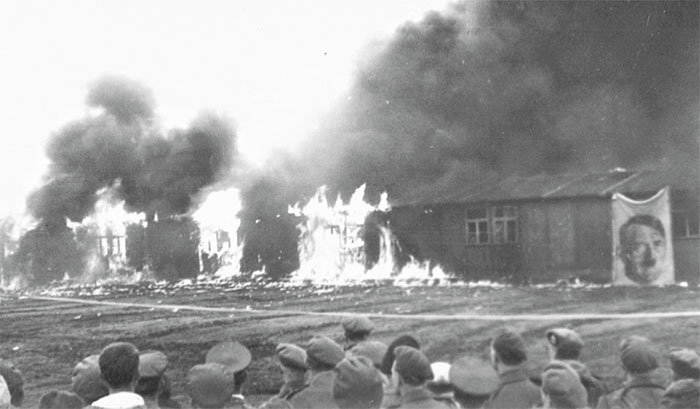Rare photographs depict the unimaginable brutality of concentration camps from World War II.
On April 15, 1945, Allied soldiers from Russia, Britain, and the United States discovered the most horrific scene of World War II at the Bergen-Belsen concentration camp. By that time, many concentration camps had been liberated, including Auschwitz, but Bergen-Belsen left the deepest impression on the soldiers who discovered it. Some veterans are still haunted by the terrifying images from 80 years ago.

Here, there were around 80,000 corpses and 13,000 other prisoners who had died earlier due to poor health conditions. (Source: historyofyesterday.com)
At each camp, there was always a photographer assigned by the U.S. military to document what was seen in order to provide more detailed reports to higher-ranking officers across the ocean. Initially, in 1940, Bergen-Belsen was established as a prisoner of war camp where most of the captured Allied soldiers were gathered. In 1943, the SS decided to turn it into a death camp.
Most prisoners brought here were from other concentration camps that were overcrowded. Some prisoners were transferred to Bergen-Belsen as part of a “death march” intended to kill them slowly and painfully. In 1945, as Allied forces were pushing back German troops, the SS were ordered to kill as many prisoners as possible before the Allies discovered the camp.
The First Witness to the Horror
Lieutenant John Randall was the first to encounter the prisoners at Bergen-Belsen and witnessed the brutal actions. In a published book titled “The Last Gentleman of the SAS: A Moving Account from the First Allied Officer to Enter Belsen at the End of World War II”, Randall detailed the horrors he experienced that day. Randall was an experienced soldier and, in 1945, a member of the SAS (Special Air Service).
However, even with specialized training and years of experience, he was overwhelmed by what he saw upon entering the Bergen-Belsen concentration camp, as he mentioned in his book. The young SAS officer led a small team of the first soldiers on the Western Front. When he saw the metal gates of the camp, he thought it was the entrance to a large farm. Bergen-Belsen was located in northern Germany, and the Allies discovered it quite by chance as they stumbled upon it along a winding road through a dark forest of pine and birch.
Intrigued, Randall ordered his sergeant to turn the Jeep left. Randall saw two unarmed SS soldiers who seemed indifferent to the presence of the Allied soldiers. They spoke English fairly well and told Randall that they had been left behind and, in that case, they had no hope or enthusiasm to continue fighting, so they waited for the Allies, resigned to whatever fate awaited them.
What he witnessed made Randall regret being born into this world. The deeper they ventured into the camp, the more corpses they encountered. Soon after, they were approached by some survivors, who were extremely malnourished, with bony bodies, pale skin, and expressionless faces. The survivors begged the Allied soldiers for help but could not provide any as they had no supplies. Randall tried to say a few words and advised the survivors to wait, that a relief army would come…
A Hell on Earth
In the camp, there were approximately 80,000 corpses and 13,000 other prisoners who had previously died due to poor health conditions. Most survivors were found huddled together in huts, occasionally checking each other for signs of life. The smell and atmosphere around were unlike anything in this world. Only rare photographs recently declassified can depict this hell on earth.
“The dead and the dying lay close together. I walked over corpse after corpse until I heard a voice softly moaning above me. I found a girl – a living skeleton. It was impossible to guess her age, as she had virtually no hair on her head, and her face was just a sheet of yellowed skin, with two holes for eyes” (words of Corporal Ian Forsyth).
Some survivors were so weak that others who had died lay on top of them, and they could not move those bodies, nor did they have the strength to cry out for help. Some survivors may have been buried alive along with others. Despite the large number of people killed at Auschwitz, the slaughter at this camp is felt to be the most significant, simply because it is where the largest number of corpses were concentrated in one place throughout the war.

Bergen-Belsen is one of the few concentration camps that the Allies burned down. (Source: historyofyesterday.com).
Most of the photographs taken at Bergen-Belsen of the corpses were made by Charles Martin King Parsons, a member of the same SAS team. These photographs remained unknown until 2015 when his nephew, Tom Marshall, decided to publish them after finding them in an old box where Parsons kept his war memorabilia.
Bergen-Belsen may be one of the last concentration camps to be discovered, but it certainly left the deepest impression. This was the moment when the world truly understood the meaning of genocide and the evil brought about by Hitler’s perverse ideology. Despite the horrific wars that had occurred in human history, nothing could compare to the hell created at Bergen-Belsen.


















































